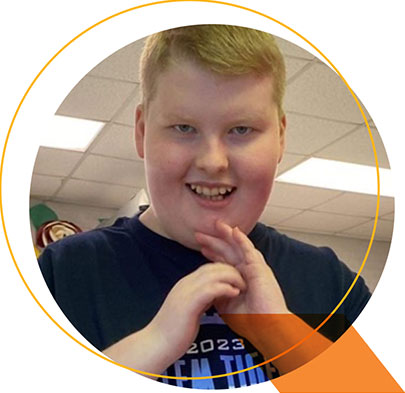
What is Prader-Willi Syndrome? Understanding PWS symptoms, challenges, and treatments.
Prader-Willi Syndrome is a rare genetic disorder characterized by an inability to feel full.
We have all eaten past the point when we feel full, often because we eat faster than our brains can signal to us that we’ve had enough. For neurotypical people, this may result in feeling uncomfortably “stuffed” after sufficient time has passed. For those with Prader-Willi Syndrome (PWS), that feeling never occurs.
PWS is an extremely rare genetic disorder resulting from an abnormality on the 15th chromosome. People with PWS experience what is known as polyphagia, or hyperphagia — an abnormally strong craving for food that cannot be satisfied. Since it was first described in 19561, PWS has been studied extensively. While the condition poses significant challenges, there are now a range of effective pharmacological and therapeutic interventions available to make life more manageable for these individuals.
Here, we explore the symptoms of PWS, as well as the causes and treatments available for this rare condition.
people are born with PWS2
What are the symptoms of Prader-Willi Syndrome?
PWS is associated with a complex cluster of physical, cognitive, and behavioral challenges. In addition to an insatiable craving for food, people with PWS are prone to weak muscle tone, developmental delays, intellectual disability, and behavioral issues — all of which can make raising a child with PWS exceptionally challenging.
Let’s take a closer look at PWS symptoms.
Let's take a closer look at the symptoms of severe autism
What are the symptoms of Prader-Willi Syndrome?
PWS is associated with a complex cluster of physical, cognitive, and behavioral challenges. In addition to an insatiable craving for food, people with PWS are prone to weak muscle tone, developmental delays, intellectual disability, and behavioral issues — all of which can make raising a child with PWS exceptionally challenging. Let’s take a closer look at PWS symptoms.
Hyperphagia, or a chronic feeling of hunger.
Starting around age 2, children with PWS begin to experience an unrelenting urge to eat, which can lead to overeating and rapid weight gain. Yet no matter how many calories they consume, they still feel hungry. To complicate matters further, people with PWS have unusually low caloric needs, which increases the risk of obesity and related conditions, such as diabetes.
fewer calories than children without PWS 3
Hypotonia, or weak muscle tone.
Hypotonia refers to decreased muscle tone — the amount of tension or resistance to stretch in a muscle. In individuals with hypotonia, the muscles appear less firm and may feel soft or floppy. The condition is often noticeable at birth and can be identified by a lack of resistance to the passive movement of joints. Since muscle mass is essential for maintaining a healthy weight, hypotonia contributes to the risk of life-threatening obesity in those with PWS.
Slowed growth and development.
In the first years of life, infants with PWS demonstrate what is referred to as a failure to thrive. Crucial developmental milestones, such as sitting and walking, are often delayed due to severe hypotonia and slow weight gain. They may also demonstrate poor sucking and other feeding difficulties, as well as cognitive delays that can impact the learning and application of motor skills. While symptoms of PWS do not worsen over time, they change with age.
Delayed milestone achievement in infants with PWS.
Independent sitting
Average
Infants with PWS
months
months
Single words
Average
Infants with PWS
months
months
Walking
Average
Infants with PWS
months
months 4
Intellectual disability.
The type and severity of intellectual disability among people with PWS varies widely, ranging from mild to severe. Cognitive challenges include slower processing speeds, difficulty with memory retention, poor problem-solving and reasoning skills, and difficulty with abstract concepts. In addition to struggles at school, these challenges can impact their ability to understand complex concepts and apply logic to everyday situations.
Behavioral issues.
PWS is also associated with extremely challenging behaviors. In search of the feeling of fullness, or satiety, children with PWS may obsess over, hoard, or steal food. In some cases, they will even resort to eating inedible substances. Those with PWS are also prone to emotional dysregulation, leading to frequent temper tantrums and outbursts over minor frustrations, often triggered by changes in routine or denial of food. They may also struggle in social situations, sometimes exhibiting inappropriate behaviors due to a lack of understanding of social norms.
What is the treatment for PWS?
While there is no cure for PWS, there are many effective treatments for managing the condition. Indeed, with the right care, therapy, and medication, people with PWS can live fulfilling and enjoyable lives.
Given the complexity of the disorder, successful treatment for PWS must be interdisciplinary and multifaceted. Let’s explore the specialists, educators, and caregivers that make up a well-rounded PWS care team.

Behavioral therapists.
Behavioral therapy plays a crucial role in managing the challenging behaviors and emotions associated with PWS. Through therapeutic intervention, individuals with PWS can learn coping strategies to help manage their preoccupation with food. Positive reinforcement, clear and consistent consequences for unhelpful behaviors, and instruction on how to express emotions appropriately can all help with reducing problem behaviors. Likewise, social skill training allows people with PWS to practice healthy interpersonal behaviors, understand social cues, and thereby enhance the quality of their interactions with others. Making progress in each of these domains can, in turn, decrease symptoms of anxiety and depression often associated with PWS.

Physical, occupational, and speech therapists.
Other effective types of therapy include physical and occupational therapy, as well as speech-language pathology. Physical therapists can help people with PWS improve muscle tone and motor skills through targeted exercise. Similarly, occupational therapy can help with fine motor skills and activities of daily living. Developing proficiency in these areas increases independence and, as a result, boosts confidence and mood. Speech-language pathologists may also prove beneficial for those with PWS, as they can address any delays in speech and language development.

Primary care and specialist physicians.
Regular check-ups are an essential aspect of maintaining overall wellness in patients with PWS. Common co-occurring conditions such as sleep apnea, diabetes, scoliosis, skin picking, and endocrine disorders may require specialized care and medication. Growth hormone therapy, for example, has been shown to increase cardiac mass while decreasing the size of the left ventricle, resulting in improved metabolism and an overall decrease in cardiovascular risk5. Psychotropic medications — such as antidepressants, mood stabilizers, and stimulants — may also help with emotional and behavioral symptoms, depending on the individual’s needs. A study by the Nexus Hope Foundation has also evaluated the effectiveness of Naltrexone in treating dermatillomania, or skin-picking, which is a common secondary behavioral disorder associated with PWS.6

Educators.
Finding the right educators for children, and even adults, with PWS can significantly impact quality of life. Tailored educational programs can not only teach academic and life skills, but also enrich their quality of life by introducing intellectual interests and a community of peers with whom they can learn and explore. A comprehensive evaluation can help caregivers select the most appropriate learning environment for their children.

Parents and caregivers.
Perhaps the most important part of the PWS care team, parents and caregivers have the ability to create a structured home environment in which people with PWS can thrive. Basic measures such as restricting food access, increasing food security by adhering to schedules, providing consistent discipline and positive reinforcement, and encouraging regular physical activity are all essential for long-term wellness and quality of life.
When is an inpatient PWS program necessary?
For some children, outpatient therapy and primary care can effectively manage symptoms of PWS. For those with extremely maladaptive behaviors and life-threatening co-morbidities, on the other hand, inpatient programming may be the only way to ensure long-term health and stability. Intensive daily supervision can reduce the long-term burden of care by treating the myriad life-limiting symptoms associated with PWS.

Some of the challenges that warrant admission to an inpatient PWS program include:
- Loss of muscle tone or muscle wasting
- Respiratory complications secondary to obesity
- Life-threatening weight gain
- Unmanageable behaviors
- Infection due to dermatillomania, or skin-picking
- Severe edema
- Cellulitis

Giving children with Prader-Willi Syndrome and other weight-related disorders a jump start on their health and wellness goals.
Nexus’ Jump Start Program offers the only nationally recognized inpatient programming designed to treat the weight and behavioral issues associated with Prader-Willi Syndrome and other disorders resulting in childhood obesity. We have created a safe, structured environment in which children can reach their weight loss and wellness goals under the care of an interdisciplinary team.
Jump Start Program Features
-
Decrease body mass index (BMI)
- Increase physical mobility
- Resolve weight-related conditions
- Develop strategies to manage behavior
- Decrease unstructured time
- Develop coping skills for at home, school, or in the community
- Improve overall quality of life

Meet our Champions.
“I never would have thought that this could be my boy. I look back now at videos of him before Nexus, and it’s hard to believe that was him. He’s not the same kiddo. He got so independent.”
— Alicia Hasten, Brody’s mother
“Jump Start gave our family the knowledge, guidance, and confidence to support Kahlil’s journey to being healthy.”
— Leon Caldwell, Kahlil’s father

Sources:
- Prader-Willi Syndrome: a review of clinical, genetic, and endocrine findings | Journal of Endocrinological Investigation
- What is Prader-Willi Syndrome? | Foundation for Prader-Willi Research
- A Personalized Approach to Determining the Caloric Needs of Children with Prader-Willi Syndrome Treated with Growth Hormone | Journal of Clinical Medicine
- Prader-Willi Syndrome and the Younger Child | IPWSO
- The Importance of Growth Hormone Therapy for PWS | Foundation for Prader-Willi Research
- Naltrexone for the treatment of skin picking disorder in patients with Prader-Willi Syndrome: A retrospective study | Nexus Hope Foundation
